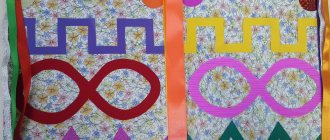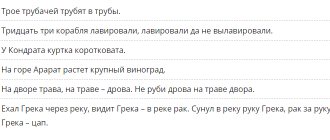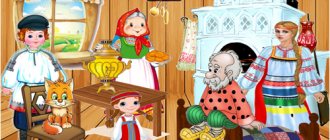Summary of individual-subgroup speech therapy sessions
Type of activity: discovery of new knowledge. Group of children according to the structure of speech impairment: ONR - 3rd level. Age of children: 6-7 years - preparatory group Topic: Sounds L - Ry Priority educational area: Speech development Integration of educational areas:
- Social and communicative development
- Cognitive development
- Physical development
- Artistic and aesthetic development
Goal: Differentiation of sounds L - R in syllables, words and phrases.
Lesson summary on the topic “Differentiation of sounds L-L”
Differentiation of sounds [l] – [l']
Correctional educational goal:
- Strengthen the skills of distinguishing by ear the sounds [L] - [L'] and using them correctly in speech.
- Strengthen the ability to use models when analyzing the articulatory structure, improve the skills of conducting sound analysis using the example of the word fork.
- To develop practical skills in forming relative adjectives from nouns denoting the names of fruits and berries, to consolidate the ability to coordinate nouns with adjectives, cardinal numbers with nouns.
- Expand and activate vocabulary on the topics “Fruits”, “Berry”, “Tableware”.
- Develop practical skills in writing proposals, negotiating sentences based on clarity.
Corrective and developmental goal:
- Develop gross and fine motor skills, long speech exhalation, phonemic perception, attention.
Corrective educational goal:
- Form a culture of behavior at the table, cultivate kindness, responsiveness, and the ability to see the good and positive in the actions of comrades.
Equipment:
picture material (frog, table, bowl of salad, fruit, berries); handout picture material (apple, banana, orange, currant, strawberry, lemon, raspberry, pear, models of spoons and forks), cards for analyzing the articulation of sounds [L] - [L'].
Organizing time.
Forming a culture of behavior at the table, creating a positive attitude towards learning.
Speech therapist.
Guys, Bill the Frog invited us to visit.
Let's remember how to behave at the table.
On the frog's birthday, her friends gathered. We frolicked, played, and then began to have lunch. They forgot only one thing: the guests did not wash their hands. Treats at the tables were taken with dirty hands. G. Shalaeva
Guys, name the first rule of behavior at the table.
Children.
Wash your hands before eating.
The child who names the rule goes to his/her table.
Speech therapist.
Now listen to what happened to my friend the stork.
The stork at the table was sad: He decided to eat the soup with a fork, But he couldn’t do it - Nothing worked! G. Shalaeva
Formulate the second rule of behavior at the table.
Children.
Use cutlery correctly.
Speech therapist.
The little bear was chewing bread and dropping bread crumbs. He spoke with his mouth full - What? No one could understand, Then he took up the compote - The table doused his stomach too! G. Shalaeva
- Name the third rule.
Children.
Eat slowly and carefully, do not indulge at the table.
Speech therapist.
And the last important rule: thank the hosts after dinner.
Report the topic of the lesson.
Isolating sounds [L] - [L'] from a number of words.
Speech therapist.
Listen to the words, what sound occurs in each word.
Table, chair, spoon, fork, plate.
Children.
Sound [L].
Speech therapist.
Table, chair, food, drink, saucepan.
Children
. Sound [L'].
Speech therapist.
Today we will play with these sounds.
Development of speech exhalation, development of auditory attention.
Game “Steamboat - droplet”.
Speech therapist.
If I say the word steamboat, you begin to hum for a long time, like a steamboat: inhale, as you exhale - [LLLLLLLLLLLL].
If I say the word droplet
, then you will pronounce the sound [L'] briefly, as if water is dripping from a tap: inhale, as you exhale - [L' - L' - L' - L'].
Updating children's existing knowledge.
Characteristics of sounds by articulatory and acoustic characteristics.
Speech therapist.
What do our teeth, tongue, lips do when we pronounce the sound [L], the sound [L']?
Children analyze articulation using model cards.
Speech therapist.
What else can we say about these sounds?
Children.
These sounds are consonants, voiced, but the sound [L] is hard, and the sound [L'] is soft.
Development of phonemic awareness, improvement of general motor skills.
Game “Pick it up and slam it down”.
Speech therapist.
Guys, please stand up and listen. If I say a word with the sound [L] - clap your hands, if I say a word with the sound [L'] - raise your hands.
Pan, spoon, plate, butter dish, milk jug, salad bowl, fork, saucer, glass, bread box.
Development of fine motor skills.
Finger gymnastics “Washing hands”.
Speech therapist.
Guys, you said that you need to wash your hands before eating. Get your hands ready.
Our Mila washed her hands. (“We wash our hands.”)
Mila did not spare soap. Mila washed every finger. Our Mila is great!
(Use your thumb to “wash” each finger in a circular motion).
Coordination of cardinal numerals with nouns, development of auditory-speech memory, phonemic perception, pronunciation of sounds [L] - [L'] in syllables.
Game “Count the objects”.
Speech therapist.
Bill the Frog brought you cutlery (models of spoons and forks), but he doesn’t know how to count yet. Count how many cutlery is on your table.
Children.
One spoon, two spoons, three spoons, four spoons, five spoons. One fork, two forks, three forks, four forks, five forks.
Speech therapist.
As many models as there are in front of you, say the syllable LA, LA, OL, OL, PLA, PLYa so many times.
Children.
LA-LA-LA-LA-LA. LA LA LA LA LA. OL-OL-OL-OL-OL. OL-OL-OL-OL-OL. PLA-PLA-PLA-PLA-PLA. PLAH-PLAH-PLAH-PLAH-PLAH.
Sound, syllabic analysis.
Speech therapist.
Determine the number of syllables in the word fork.
Children.
Two.
Speech therapist.
Name the first syllable (vil), the second syllable (ka). How many sounds are in the first syllable? Three. List them. Describe these sounds. ([B'], [I], [L]). ([V'] - consonant, voiced, soft; [I] - vowel; [L] - consonant, voiced, hard; how many sounds are in the second syllable? Two. ([K], [A]). ([K] – consonant, deaf, hard; [A] – vowel).
One of the children conducts a full sound analysis of the word.
Development of auditory attention, phonemic perception, clarification and expansion of the vocabulary on the topic “Utensils”, pronunciation of sounds [L] - [L'] in words.
Ball game “Set the table”.
Speech therapist.
Children, let's help Bill the frog set the table, he decided to take only those items whose names contain the sounds [L] and [L']. I throw you a ball and name a word, if it contains the sounds [L] - [L'], you say: “I hear.” If the word does not contain the sounds that we are playing with today, answer: “I don’t hear.”
Cup, glass, spoon, frying pan, salad bowl, fork, jug, saucer, sugar bowl, glass, decanter, butter dish, creamer.
Children.
Let's take a salad bowl, spoon, fork, saucer, glass, butter dish, creamer.
Clarification and expansion of the dictionary on the topic “Fruits”, “Berry”, formation of relative adjectives from nouns denoting the names of fruits and berries, agreement of adjectives with nouns.
Game “Make a salad”.
Speech therapist.
Bill the Frog decided to make a fruit and berry salad, let's help him. Select only those pictures whose names contain the sounds [L], [L'].
Each child is given pictures of fruits and berries.
Children.
Let's prepare a salad of strawberries and raspberries, oranges, apples, lemons.
Speech therapist.
Guys, what if you make juice from these fruits and berries? What juice will you get from apples?
Children.
Apple juice – apple juice. Strawberry juice – strawberry. Raspberry juice – raspberry. Orange juice – orange juice. Juice from lemons – lemon.
Pronunciation of sounds [L] - [L'] in a sentence. Negotiating sentences based on the picture presented, pronouncing the resulting sentences.
Game “Finish the sentence”.
Speech therapist.
Today I invited the guys to visit (shows a picture of a frog)…
Children.
Frog Bill. Today the kids were invited to visit by Bill the Frog.
Speech therapist.
The guys washed their hands and sat down at... (picture – table).
Children.
Table. The guys washed their hands and sat down at the table.
Speech therapist.
Bill the Frog treated the children to fruit... (picture of a salad bowl with salad).
Children.
Salad. Bill the Frog treated the children to fruit salad.
Speech therapist.
He prepared a salad from ... (pictures - berries, fruits).
Children.
Strawberries, oranges, raspberries, apples, lemons. He prepared a salad from strawberries, raspberries, oranges, apples, and lemons.
Speech therapist.
When leaving, the guys thanked... (picture of a frog).
Children.
Bill the Frog. As they left, the children thanked Bill the Frog.
Summary of the lesson.
Speech therapist.
Guys, today we visited the little frog. We remembered how to behave at the table, played with the sounds [L] and [L']. You did a very good job, who would you personally like to praise? Leave your tables and say kind words to each other.
Lesson summary on the topic: “Differentiation of sounds l-l. Senior preschool age."
Prepared by: Votrina Vera LP-41
Tasks:
Correctional and educational:
- To develop the ability to distinguish the sounds L - R by acoustic characteristics;
- To develop the ability to distinguish the sounds L - R by articulatory features;
- consolidate the pronunciation of the sound L - R - in syllables, words and phrases.
- developing the skill of sound analysis of words with the sounds L, R
Correctional and developmental:
- develop the ability to encode and decode information,
- continue to develop visual and auditory attention and thinking,
- improve phonemic perception and sound analysis skills of words;
- develop speech activity, coordination of speech with movement, fine and fine motor skills.
- improve inflection and word formation skills.
Correctional and educational:
- continue to develop skills of cooperation, goodwill, and initiative.
- develop the ability to respect nature.
Planned results (goals): the child can use speech to express his thoughts and construct a speech utterance in a communication situation, can identify sounds in words and analyze the word, differentiate sounds by ear, developed gross and fine motor skills, actively interacts with peers and adults , participates in joint games, has a developed imagination.
Speech therapist's notes - Differentiation of sounds L - L
Topic: “Differentiation of sounds L - L”
Goal: - teach, differentiate sounds by ear and pronunciation.
Tasks:
- improve the skills of sound-syllable analysis and synthesis;
- teach, listen carefully to the speech of an adult, correctly understand logical and grammatical structures;
- continue to learn how to make sentences with a given word;
- learn to isolate words with given sounds from the text;
- consolidate the ability to select related words;
- strengthening the skill of agreeing adjectives with nouns.
Equipment: handouts, pictures, game “Train”, “sun”.
Progress of the lesson
1. Ogre. moment.
Finger gymnastics “Swallow”.
Game "Answer questions".
Brother calls sister home. Who is home? (Brother). Lena listened to Misha. Who spoke? (Misha). Vanya walked ahead of Petya. Who was last? (Petya). Forest behind the house. What's ahead? (House). The bus is driving ahead of the truck. What's behind? (Truck) A cat is bigger than a dog. Who is smaller? (dog) The boy is taller than the girl. Who's lower? (Girl) Grandfather is older than grandmother. Who is younger? (Grandmother) Oak is taller than birch. What's below? (birch)
Train game
Determine the number of syllables in a word. In the first carriage there are pictures with one syllable in the title. In the second car there are pictures with two syllables in their titles. In the third car there are pictures with three syllables in the name. (stork, starling, heron, crane, lily, snowdrop, cornflower, oak, maple, spruce). For example: My picture will travel in the first carriage because the word spruce has one syllable. How can you call the “passengers” in the first carriage in one word? What is this? (trees). How can you call the “passengers” in the second carriage in one word? Who is this? (birds). What kind of birds are these? (passengers) How can you call the “passengers” in the third carriage in one word? What is this? (flowers). Young green leaves appear on the trees. Migratory birds arrive from warm countries. The first flowers are blooming. What time of year does this happen? (in spring) Remember and name related words to the word spring – spring, freckles, freckles,….
2. Introduction to the topic.
The sun appears without any rays. What is the third sound heard in the word - sun (L) Today let’s remember the sounds L and L. Remind the articulation of the sound L:
- lips in a slight smile;
- the teeth are visible and close together;
- the narrow tip of the tongue is raised by the upper teeth, pressed;
- the neck "works".
(pronounce)
What prevents the air stream from coming out of the mouth? (tongue, teeth) Characteristics of sound. (consonant, hard, voiced). (given by the child) The symbol is sound. Designation. Articulation of the sound L:
- lips in a slight smile;
- the teeth are visible and close together;
- the tip of the tongue is raised by the upper teeth, pressed against the tubercles;
- the neck "works".
(pronounce)
What prevents the air stream from coming out of the mouth? (tongue, teeth) Characteristics of sound (consonant, hard, voiced). Symbol sound. Designation.
3. Game "On the contrary"
| La - la Lo - le Lu - lyu Ly - li | al - al ol - ol ul - ul il - il | bow - hatch corner - coal yula - Yulya ate - spruce | jackdaw - pebble shelf - polka |
4. Game “Catch the Sound”.
(one team “catches” the sound l, the other - the sound l) La, la, lo, le, ate, slu, walked, walked, crowbar, ice, viburnum, wicket, ear, log, cold, stripe….
5. Game “Finish the word” (l or l)
One hundred..., st..., po..., ugo..., foam..., bo..., so..., mo..., ro....
6. Game "Guess"
lapi, ka-pol, lashko, dyshlan, lo-mo-tok, pa-lota, lakuk, kalozh, ka-bel, baklum, toch-laska, shad-ka-lo.
7. Complete the word and lay out a diagram of this word..
| Ding-dong, ding-dong (an elephant) walks in the alley |
| A red fox often goes to the lake to drink |
| Christmas tree, Christmas tree, Christmas tree – Spiky (needle) |
| Even if the roof is leaking and the gate is broken, the snail will never leave its house. |
Come up with a sentence with one of the words (snail, elephant, fox). How many words are there in a sentence? Is there an excuse?
8. Physical education minute.
(remember where is right and where is left) Touch your left ear with your right hand. Touch your left knee with your left hand. Jump on your right leg three times. Jump on your left leg twice.
Game “What Can You Say About” (white, white, white, green, green, green.)
9. Isolating sounds (L, L) from the story.
“The Fox and the Goslings” Lucy was herding geese and goslings in a clearing near the forest. A fox jumped out of the forest. She saw geese and goslings. The fox hid behind the bushes. The geese and goslings ate and lay down in the clearing to sleep. They didn't see the fox. The fox crept up and grabbed one of the goslings. The fox carried the gosling away to her hungry cubs.
Count how many sentences are in the story.(8)
10. The sun continues to smile, but what is the sun missing? (rays)
Come up with words with the sound l (long rays) and with the sound li (short rays).
11. Summary of the lesson.
What sounds did we compare? Describe the sound l (l). What did you like about the lesson?
Author of the material: Medvedkova Nadezhda Gennadievna
Also on topic:
Group lesson for children with phonemic speech underdevelopment






